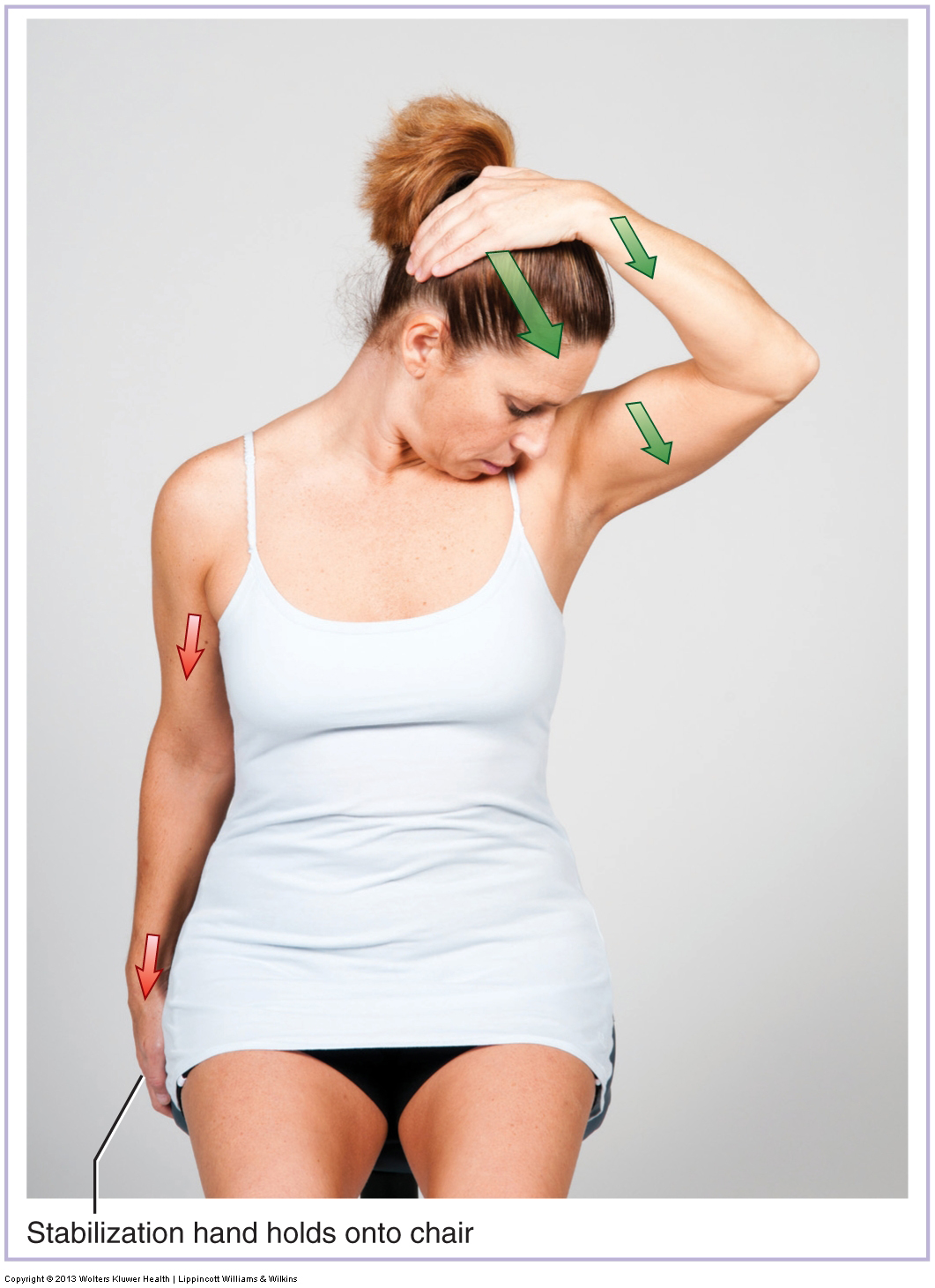Self-care for the client/patient with spasmed neck muscles:

Self-care stretch for the neck into flexion, lateral flexion, and contralateral rotation. Permission: Joseph E. Muscolino. Advanced Treatment Techniques for the Manual Therapist: Neck (2013).
Self-care is an extremely important part of the treatment regimen for treating the client/patient with spasmed neck muscles (tight neck musculature), especially if the condition is chronic. Moist heat followed by stretching should be recommended. If the problem is severe or chronic, two to three (or more) sessions of moist heat/stretching should be done each day. It is also advisable to recommend that the client/patient minimize or avoid postures or activities that exacerbate the problem.
Medical approach:
The medical approach for spasmed neck muscles tight is usually pharmacologic. Over the counter anti-inflammatory or analgesic (pain killer) medications are usually recommended. Stronger prescription anti-inflammatory, analgesic, or muscle relaxant medications are recommended for more severe cases. Trigger point and cortisone injections may be done. Referral to a physical therapist is also commonly recommended.
Manual therapy case study:
Zee is a 35-year-old manager at a marketing firm; her job involves mostly computer and telephone work. She has been experiencing pain and tightness in the back right side of her neck for the past few weeks. On a pain scale of 0-10, she reports her pain and tightness first thing in the morning as a 6-7. The pain reduces to a 3 after taking a hot shower and moving around, but increases back to a 5-6 by the end of the day. However, on weekends when she does not need to go to work, her pain and tightness usually remain about a 2-3. She has also noticed more headaches than usual, usually located on the right side.
Verbal history reveals that Zee holds her head and neck down into flexion when working at the computer. When talking on the phone, she also tends to crimp the phone between her right ear and shoulder. She also carries a purse on her right shoulder and tends to sleep on her stomach. Postural observation shows her right shoulder to be higher than the left and her head/neck to be held in slight right lateral flexion. Her head is also protracted forward with its center of gravity imbalanced anterior to the trunk. Active range of motion of the neck reveals left lateral flexion limited to 25 degrees and flexion limited to 20 degrees. Her right-sided neck pain increased when moving into left lateral flexion.
Upon palpatory examination, Zee’s entire right posterior quadrant is tight. The greatest tightness and trigger points are found over the laminar groove in the semispinalis musculature. Further, pressure into the semispinalis reproduces Zee’s characteristic pain pattern, including referral into the head where she has been experiencing headaches. Her left side thoracic and cervical musculature is only mildly tight. All orthopedic assessment tests for a space-occupying (spinal nerve compression) condition are negative.
Given the location of Zee’s symptoms and the results of the postural and palpatory examination, it is clear that Zee has spasmed neck muscles in her right posterior quadrant, with the focus at the semispinalis. The therapist recommended one-hour massages, twice weekly for three weeks. The protocol for each session was to begin with heat for five minutes followed by mild and then moderate pressure soft tissue manipulation into the right side of the neck for approximately 10-15 minutes. Stretching and joint mobilization are then done, followed by very deep work into the semispinalis. The remaining time was spent on the left side of Zee’s neck, as well as her head and upper back.
Zee was given self-care instructions to take a hot shower and then stretch her neck three times each day. She was also asked to pay attention to her posture at the computer, to use a headset when using the phone, to stop carrying her purse on her shoulder (or to use a purse that has a longer strap than can go on the shoulder but across the body), and to try sleeping on her side or back.
At the end of three weeks, Zee’s neck pain and tightness had decreased over 90% and her headaches were gone. Care was continued at twice per week for another week and then decreased to once per week for another two weeks until Zee became pain free. For proactive self-care, Zee decided to begin taking a yoga class twice per week and to return for massage once a month.


